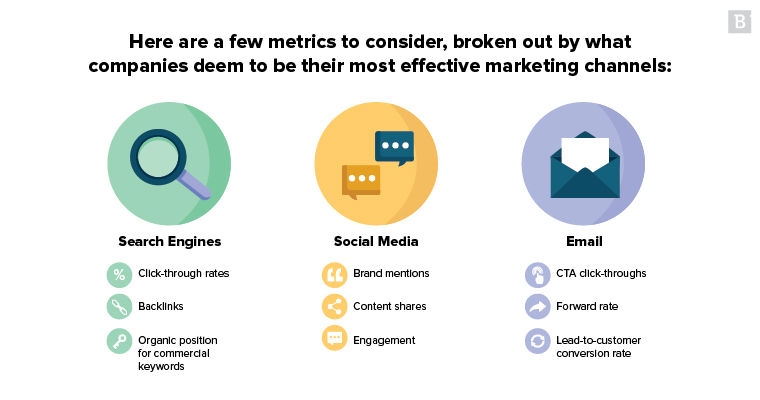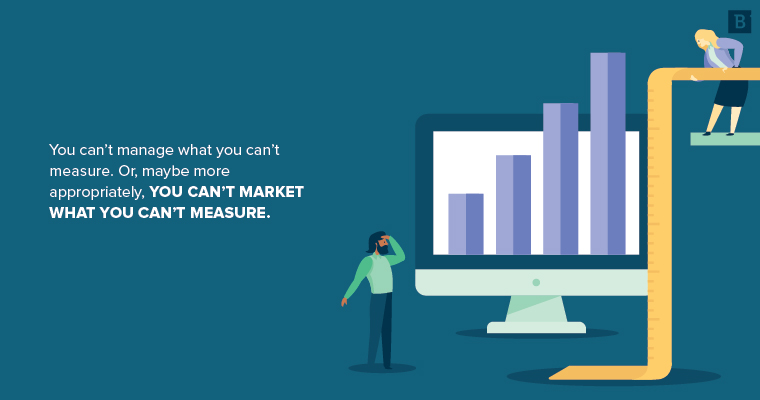You invest in marketing. You create content. You see what happens. How much money did you make? How much more loyal are your customers? What was the ROI on that tweet you sent back in April?
If you can’t answer these questions, then you’re unfortunately not equipped to measure marketing effectiveness. And if that’s the case, it’s time to pack up and go home.
Or, you can learn how to calculate every sales and marketing metric that matters to your organization

The Competitive Landscape: How Effective are Digital Marketers?
Marketing expenses have risen to an all-time high, representing nearly 14% of organizations‘ total budgets. With those heightened allocations, a majority (56%) will be funneled into digital channels and strategies, with social advertising topping the charts.
But are these investments paying off?
Well, 80% of very successful marketers have a documented content marketing strategy in place — which highlights their effectiveness tenfold. If you want to achieve marketing success, it starts with a content strategy.
So how do you measure your company’s marketing effectiveness?

Vanity vs. Value: Digital Marketing Metrics That Matter
“Thought leadership” and “social media likes” are not key performance indicators (KPIs). Neither is “brand awareness.” They’re vague, sometimes unhelpful indicators of where your mind is at. But there are plenty more KPIs that marketers live and die by (mostly die) that do not correlate to ROI and that are likely misinforming your concept of marketing effectiveness.
We call these vanity metrics, and they are as follows:
- Website traffic.
- Time on site.
- Keyword rankings.
- Bounce rate.
- Social media followers.
- Impressions.
- Pageviews.
Vanity metrics aren’t entirely useless. They’re useful when they measure the success of a marketing activity that serves a value KPI downstream, as opposed to being an end goal in and of themselves (e.g., increasing site traffic with the long-term goal of more conversions).
But you need to construct your marketing ROI framework in terms of valuable metrics that apply to the business at large, not just surface-level web analytics data.
To help with this, take a storefront approach. If your online presence was a brick-and-mortar shop, what KPIs would you actually worry about? Sales, revenue, overhead, time to purchase, repeat visits, etc. These are ultimately the best indicators of marketing performance.
In the digital marketing space, value metrics include KPIs such as:
- eBook downloads.
- Conversion rates.
- Sales-qualified leads.
- Customer acquisition costs.
- Customer lifetime value.
In short, vanity metrics look good on a surface level but don’t necessarily correlate to or infer any meaningful or tangible business results. On the other hand, value metrics provide quantifiable insight into your marketing campaign success, and can be used to inform important business decisions in the future.
Subscribe to
The Content Marketer
Get weekly insights, advice and opinions about all things digital marketing.
Thank you for subscribing to The Content Marketer!
Google Analytics: Your ROI Tracking Toolkit
To compile all of this business data, you need a simple (and free) dashboard like Google Analytics.
With just a short snippet of tracking code automatically tagged to each page of your site, Google Analytics tracks the performance of your web pages and any marketing campaigns they may be associated with. Every time a user completes a task or interacts with your site, that information is fed into reports, which allows you to calculate the value of each web lead and how much money they bring to the table.
Assigning actual dollar values at this level of granularity is how you measure marketing effectiveness, plain and simple.
How to Use Google Analytics
Getting started with Google Analytics is pretty straightforward, and no more than a 3-step process, including:
- Obtaining an Analytics Property ID.
- Adding the Analytics Property ID to your site.
- Viewing your data.
For a more comprehensive rundown and additional resources, check out this Google Support post.
If you prefer alternative ROI reporting tools, here are a few to consider:
- Semrush.
- Adobe Analytics.
- Heap.
- Pendo.

Counting Conversions: The Micros and Macros Of Your Commercial Goals
To get the most out of your web analytics, you need to set up proper Goal Completions and Events Tracking functions, which string together different types of conversions within each of your marketing campaigns.
A conversion occurs whenever a desired action is taken on your site, aka a user is moving incrementally down the sales funnel. For example:
Micro conversions: actions that do not have a commercial impact but may in the future through effective nurturing. Think of these as small process milestones or baby steps.
- Newsletter subscriptions.
- eBook downloads.
- Creating an account.
Macro conversions: actions that directly lead to commercial value. These are much larger, intent-driven interactions.
- Contacting a salesperson.
- Demo request.
- Purchasing on site.
For nearly every business with an online presence, your primary goal is to increase conversions by capturing customers’ contact info (aka, lead generation), thus allowing you to move prospects into your sales pipeline (aka, lead nurturing).
Marketing Campaign Channels, and How To Measure Them
Designating “eBook download” or “newsletter signup” as a Goal Completion in Google Analytics, for instance, means Google will log the conversion, where it came from, which page the visitor landed on prior to converting, along with the subsequent actions they took. Measuring the progress and the frequency of these events keeps your digital marketing metrics-driven and forward-moving.
You can also segment the data you aggregate by the channels in which conversions occur. Integration with other enterprise tools will be necessary here.

Here are a few metrics to consider, broken down by what companies deem to be their most effective marketing channels:
Social Media
- Brand mentions.
- Content shares.
- Engagement.
Video Marketing
- Social media shares.
- Impressions.
- Average watch time.
Email Campaign
- Open rate and CTA click-throughs.
- Forward rate.
- Lead-to-customer conversion rate.
Search Engines (Websites and Blogs)
- Click-through rates.
- Backlinks.
- Organic position for commercial keywords.
The difference between impressions and click-through-rate (CTR) is an important note to make. While impressions simply measure the number of times someone saw your video, social media post, or website link, CTR is a measure of how many users actually clicked on your content.
Tracking Customers and Sales as KPIs
While analytics dashboards are great for marketing data, they may be too good at it, at least for the purposes of novice marketers who aren’t yet familiar with all the terms or features.
That’s why using core sales metrics can be useful as well. By this we mean:
- How many new customers have you gained?
- How many new sales calls have been booked?
- What are your revenue and sales growth rates?
By utilizing sales dashboards and sales as a metric, in addition to more granular marketing KPIs, you can better frame your conversations with superiors and stakeholders from different departments when it’s time to advocate for additional investment in your digital marketing campaigns.
Another way to leverage your existing customer base is to use automated customer satisfaction surveys. Knowing how positive your clients are and whether they will serve as references allows you to gauge whether your products, brand influence and content are having enough of an impact to actually earn new business.
CRM Tracking
Additionally, taking advantage of CRM platforms can help you track key customer interactions, such as:
- Purchase history.
- Email campaign metrics.
- Traffic.
These KPIs provide valuable insight that you can use to better serve customers, such as their browsing and spending habits, biological and geographical data and more.
Further, you can use your findings to understand your customers‘ experience with your brand and develop better strategies that are personalized to specific customer demographics.

Short- and Long-Term Objectives: What Matters Most To You?
The quick answer to this question is revenue, both now and tomorrow.
But such a high-level goal isn’t all that practical on a daily basis when you’re tasked with executing a strategy. And digital marketing isn’t going to reap immediate rewards in every case.
For example, inbound marketing can often take 6 months before ROI materializes. A knowledgeable agency partner will tell you that your content marketing investments should be understood through the lens of annual return – some campaigns won’t pay off for a year or more. Don’t jump ship too soon simply because your near-term goals were too ambitious.
Conclusion
Social media influencers, experimental web design and interactive visuals have impacted consumers and businesses alike.
Marketing automation is now the norm, and artificial intelligence creeps into everyday marketing tasks faster than many expected, as ChatGTP and DALL-E 2 have shown.
What this means for the average digital marketer is that measuring effectiveness becomes all the more paramount. Accurately measuring marketing success can actually be a brand differentiator, a mechanism for knowing how and where to target greater market share.
You can’t manage what you can’t measure. Or, maybe more appropriately, you can’t market what you can’t measure.
Editor’s Note: Updated May 2023.






